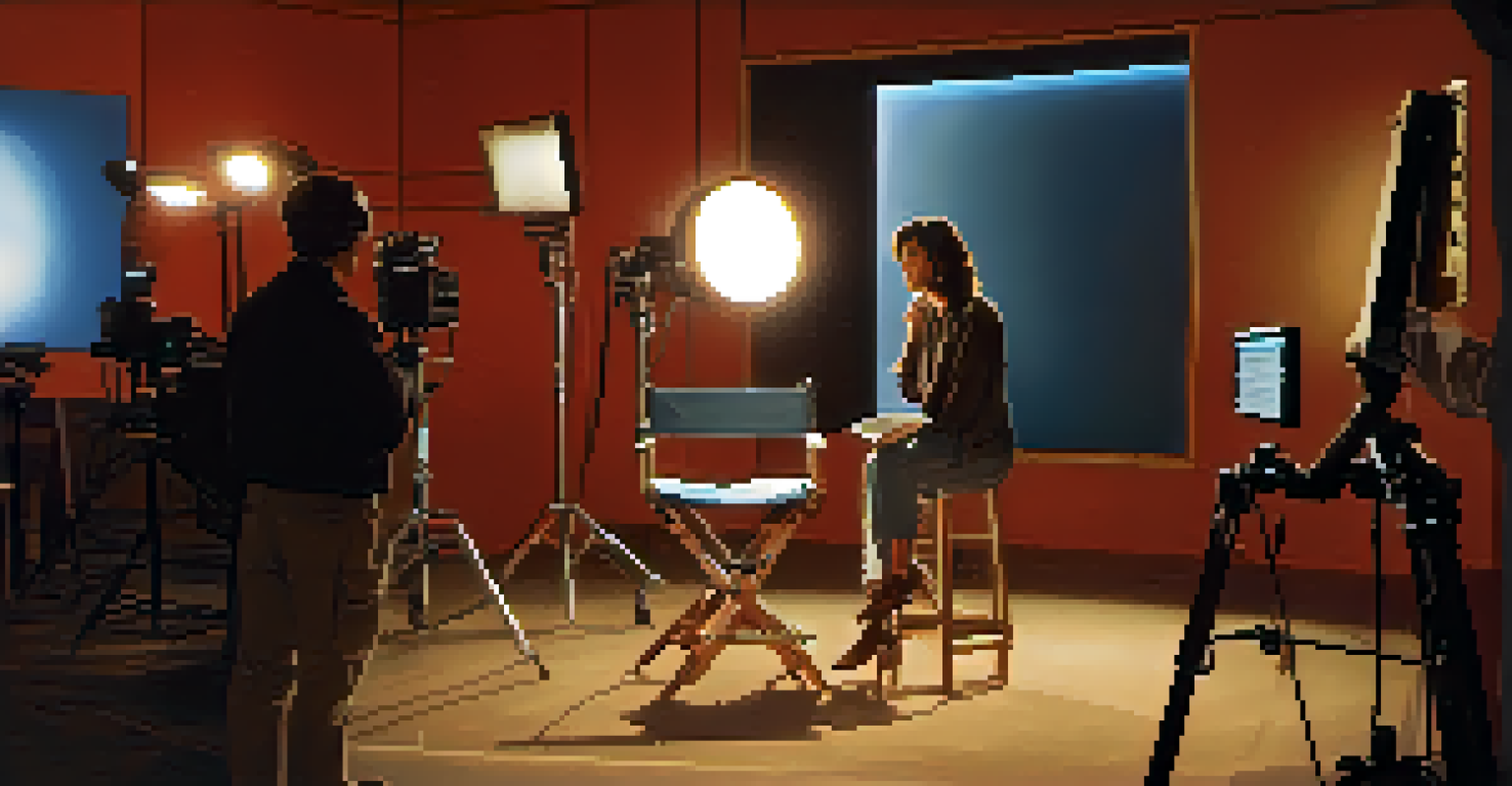The Psychological Influence of Voiceover in Film Characters

Understanding the Power of Voice in Film
Voice is a powerful tool in film, capable of conveying emotions and intentions. It adds depth to characters, allowing audiences to connect on a personal level. Think about how a soft, soothing voice can evoke feelings of comfort, while a harsh, booming voice can instill fear or authority.
The voice of a character can shape audience perception in profound ways.
This influence is not just about the words spoken; it's about tone, inflection, and pitch. For instance, a character's uncertainty can be expressed through a shaky voice, making the audience more empathetic. The sound of a voice can color our perceptions long before we see a character's actions.
Ultimately, the voiceover serves as a bridge, linking the audience's emotions with the narrative. It enriches the storytelling experience, making it memorable and impactful. In many ways, it shapes the very essence of how we perceive the characters on screen.
Voiceover and Character Development
Voiceovers often provide insights into a character's thoughts and motivations. This inner dialogue can reveal complexities that actions alone might not convey. For example, in films where characters undergo significant transformation, voiceover can effectively illustrate their internal struggles and growth.

When a character expresses their fears or dreams through voiceover, it creates an intimate connection with the audience. This technique allows viewers to understand the character's journey on a deeper level. It's like hearing a friend's confessions, which draws you in and makes you root for them.
Voice Adds Depth to Characters
Voiceovers effectively convey emotions and intentions, allowing audiences to form deeper connections with characters.
Moreover, voiceovers can highlight contrasts between how a character sees themselves and how others perceive them. This dual perspective can lead to richer storytelling and a more nuanced understanding of the character’s role within the film.
Creating Emotional Resonance with Voiceover
The emotional impact of a voiceover is often tied to its delivery and the actor's skill. A well-placed pause or a tremor in the voice can evoke tears or laughter. For instance, a nostalgic reminiscence shared through voiceover can transport viewers back to similar experiences in their own lives.
Voiceover can effectively illustrate their internal struggles and growth.
Voiceovers can also set the tone for scenes, guiding audience emotions. A melancholic voice can soften a heart-wrenching scene, while an upbeat one can elevate an otherwise dull moment. This manipulation of emotion is a subtle but powerful aspect of film storytelling.
Furthermore, the emotional connection established through voiceovers can linger long after the credits roll. Audiences may leave the theater reflecting on the character's journey, feeling a sense of investment in their story. This lasting impression is what makes voiceovers a vital part of cinematic experiences.
Voiceover as a Tool for World-Building
Voiceovers do more than deepen character development; they also enhance world-building. By using a character's voice to describe their surroundings or experiences, filmmakers create a richer context for the audience. This technique immerses viewers into the film's universe, making it more relatable.
For example, in fantasy films, voiceover can explain lore or background that might not be evident through visuals alone. A character describing their realm can paint a vivid picture in the audience's mind, enhancing their understanding and appreciation of the story. It’s akin to an engaging tour guide leading you through an extraordinary landscape.
Voiceover Enhances Storytelling
By providing insights into characters' thoughts, voiceovers enrich narratives and foster emotional resonance.
Additionally, voiceovers can establish the emotional climate of a setting. When a character reflects on a dark past while exploring a vibrant landscape, it creates a striking contrast, deepening the viewer's experience. This interplay between voice and visuals adds a rich layer to the narrative.
The Role of Accent and Dialect in Voiceover
Accents and dialects in voiceovers play a crucial role in shaping character identity. They can signal everything from cultural background to social status, influencing how audiences perceive characters. For instance, a character with a regional accent may evoke familiarity or authenticity, while a posh accent might suggest elitism.
Moreover, accent can carry emotional weight. A character returning home might revert to their childhood dialect, signaling nostalgia and connection to their roots. This subtle shift can evoke powerful emotions in the audience, creating a more immersive experience.
Ultimately, the choice of accent and dialect in voiceover helps to build a character’s backstory and enriches their personality. It adds layers of meaning that enhance the storytelling and helps the audience relate to the character on a deeper level.
Voiceover's Impact on Audience Perception
The voice of a character can shape audience perception in profound ways. A soft-spoken villain may elicit unexpected sympathy, while a loud hero can become grating. This dynamic shows how voiceovers can challenge stereotypes and alter expectations.
Additionally, voiceovers can manipulate audience empathy. When a character shares their vulnerabilities, it invites viewers to see them as multifaceted rather than one-dimensional. This deeper understanding can lead to greater emotional investment in the character’s journey.
Accents Shape Character Identity
The use of accents and dialects in voiceovers plays a crucial role in defining character backgrounds and influencing audience perceptions.
In essence, the psychological influence of voiceover extends beyond entertainment; it plays a pivotal role in shaping our perceptions of morality, heroism, and empathy in film.
The Evolution of Voiceover in Modern Cinema
Voiceover has evolved significantly over the years, adapting to changes in storytelling and audience expectations. In earlier films, voiceovers were often used to provide exposition, but now they serve more nuanced roles. Today, they are crafted to enhance character development and emotional resonance.
Modern filmmakers are increasingly using voiceover as a tool for experimentation. It can blur the lines between reality and fiction, creating a unique viewing experience. For instance, unreliable narrators often use voiceovers to leave audiences questioning the truth of what they see.

As technology advances, the methods of recording and integrating voiceovers are also evolving. With the rise of AI and voice modulation, the possibilities for character voiceovers are expanding, leading to even more innovative storytelling techniques.